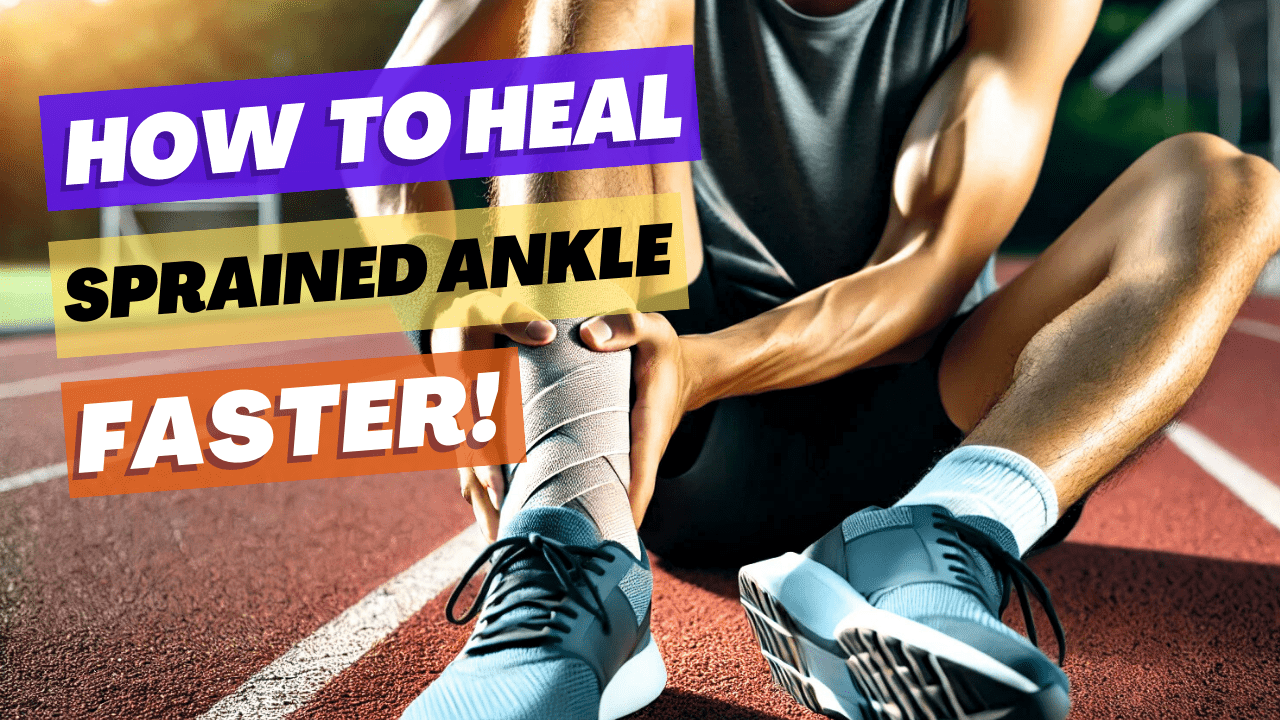That sudden twist, the sharp pain, and the immediate swelling – we’ve all been there. Whether you’re an athlete, runner or just had a wrong step, knowing how to heal a sprained ankle quickly can mean the difference between a quick recovery and weeks of pain.
Table of Contents
What Is Ankle Sprains Injury?
A rolled ankle, also known as an ankle sprain, happens when the ligaments supporting the ankle stretch beyond their limits or tear. This can be caused by sudden twists, falls, or impacts. Recognising the symptoms and the severity of the sprain is the first step toward effective healing.
Why Ankle Sprains Are So Frustrating?
You’re stuck on the couch, unable to walk properly, and daily tasks become a real challenge. A bad ankle sprain can keep you away from work, sports, and normal activities for 4-6 weeks if not treated correctly. The worst part? Without proper treatment, you risk:
- Chronic ankle instability
- Repeated sprains
- Long-term joint problems
- Weakened ankle muscles
Assess the Severity of the Ankle Injury
Before you start any treatment, it’s crucial to assess the severity of your sprain. Here’s how to identify if you’re dealing with a mild, moderate, or severe sprain:
- Mild Sprain: Minimal swelling, slight pain, but you can still put weight on the ankle.
- Moderate Sprain: Swelling and bruising are present, and it’s painful to walk.
- Severe Sprain: Severe swelling, intense pain, and inability to bear weight.
If you have a severe sprain, it’s best to see a healthcare provider. For mild to moderate sprains, follow these steps to start healing your sprained ankle quickly.

Immediate Action to Heal a Sprained Ankle Fast (Day 1-3)
To heal your ankle injury quickly, start with the RICE method:
- Rest: Keep weight off the injured ankle
- Ice: Apply for 15-20 minutes every 2-3 hours
- Compression: Use an elastic bandage
- Elevation: Keep your foot above heart level
Pain Relief and Anti-Inflammatories
Taking over-the-counter anti-inflammatory medication like ibuprofen can help with pain and reduce swelling. Be sure to follow the recommended dosage, and consult with a doctor if you have any health concerns related to NSAIDs (Non-Steroidal Anti-Inflammatory Drugs).
Gentle Exercises to Heal a Sprained Ankle Quickly (Day 4-7)
After the initial 48 hours, continuing care is crucial for healing a sprained ankle quickly. Here’s what you can do:
Gentle Exercises:
Once the initial pain and swelling reduce, begin gentle range-of-motion exercises. These exercises help restore movement and strengthen the ankle.
- Ankle alphabet: Draw the alphabet with your toes
- Towel stretches: Pull your toes back with a towel
- Simple range-of-motion exercises
Pro tip: Start these exercises only when you can handle them without severe pain.
Progress to Strengthening Phase (Week 2-3)
- Standing calf raises
- Resistance band exercises
- Balance exercises on stable surfaces
- Walking in a swimming pool
Remember: More than 80% of ankle sprains improve significantly within 2 weeks when following proper recovery steps.
Physio Therapy
If the sprain is severe, physical therapy may be necessary to fully heal the ankle injury quickly. A therapist can provide exercises and treatments to aid in recovery.
Return to Activity Phase (Week 3-4)
To recover quickly from the ankle sprain, gradually return to normal activities:
- Start with straight-line walking
- Progress to Figure 8 walking
- Add light jogging on flat surfaces
- Return to sport-specific movements
Professional Help
- Consider physical therapy – studies show it can cut recovery time by 30%
- Get a proper diagnosis if pain persists beyond 5 days
- Use kinesiology tape for added support
What to Avoid?
When trying to heal a sprained ankle fast, don’t:
- Rush back to full activity too soon
- Skip the initial RICE protocol
- Ignore sharp or persistent pain
- Walk without proper support
- Apply heat in the first 48 hours
Recovery Timeline
- Day 1-3: Focus on RICE and minimal movement
- Day 4-7: Begin gentle exercises and partial weight-bearing
- Week 2: Increase activity with protection (Strengthening)
- Week 3-4: Return to normal activities
- Week 4-6: Full recovery for most cases

Long-term Care to Prevent Future Ankle Sprains Injuries
Preventing future injuries is just as important as healing the current one. Here are some tips:
- Strengthening Exercises: Regularly performing ankle-strengthening exercises can help prevent future sprains.
- Proper Footwear: Wearing supportive shoes can reduce the risk of ankle injuries.
- Pay Attention to Surfaces: Be cautious when walking or running on uneven surfaces.
In summary, learning how to heal a sprained ankle faster isn’t just about following steps – it’s about being smart and consistent with your recovery. By following the steps outlined in this guide, you can cure a sprained ankle quickly and get back to your daily activities. Remember, patience is key, and a gradual return to activity will help you fully recover.
Frequently Asked Questions (FAQs)
Is it possible to recover from a sprained ankle?
Yes. First degree is categorised and should take one to two weeks to heal while second and third degree take three to six weeks to heal. In severe cases, sprains may require physical therapy and may take as long as months to heal.
Which remedy is more effective in case of a sprained ankle, heat or ice?
Ice should be applied to the area within the first 48 hours to reduce inflammation, as well as, the pain from inflammation. Use heat after 48 hours of the injury on the hurt area to reduce muscle tightness and increase blood flow.
What are the exercises that I can do to avoid re-injuring myself?
The essential therapies include balance exercises, calf raises, and ankle stretching exercises. Swing training on a balance board, taking a one-foot standing exercise or even simply pulling exercises with a resistance band can go a long way toward making the ankles strong enough and well-prepared should another sprain happen.
Is there any way to decrease the inflammation even more quickly?
These include icing, compressing it and then raising the area above heart level as these are known to help in reducing swellings. Activities like light massage with your hands around the area (but do not step on the sprain area).
Can I wear an ankle support to bed?
Ankle wraps do not prevent you from sleeping and you can wear them at night as long as it is not tight. Lying down should in some way aid in controlling swelling, but be careful that something is not constricting circulation. If you feel discomfort, you can loosen the wrap.
Is it possible to exercise all the other muscles in my body while I am nursing a sprained ankle?
Yes, but, you should avoid lower-body workouts, or in general, any exercise that puts pressure on the ankle part of your body.
When should I go seeking more medical attention for an ankle sprain?
If all these signs are observed – pain severe enough to warrant a visit to the doctor, inability to place any weight on the affected joint, bruises that travel up the leg, and no improvements in swelling after three days, then you should see a doctor. In some cases, an X-ray may be required to eliminate the possibility of fractures.
If you’re curious about other running injuries, check out my post ‘Achilles Pain After Running? Here’s How to Treat and Prevent It!‘





Wow, I’m blown away by the depth of research and analysis in your blog post. It’s clear that you’re passionate about this topic, and it really shines through in your writing.
I appreciate how comprehensive this article is.
I’ve shared your blog post with all my friends – it’s too good not to! Can’t wait to see what you write next.
[…] the ground, and to provide stability on uneven surfaces. This stability is important for preventing ankle sprains or other foot […]